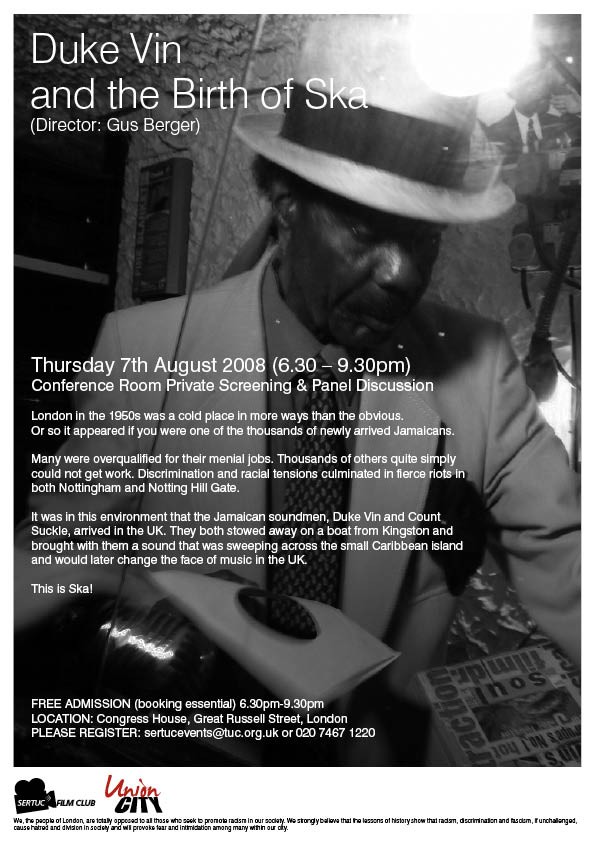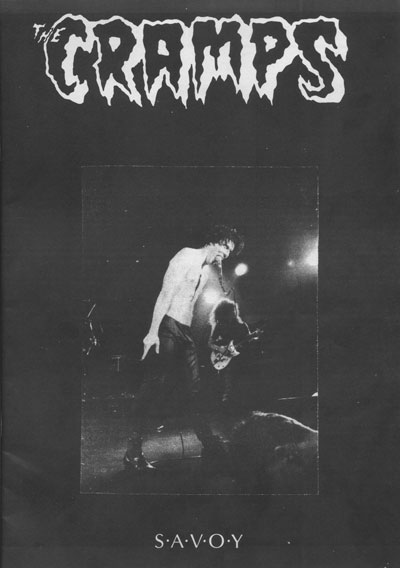Have your earplugs at the ready as Stevie Chick traces the parallel lives of two furious, noisy and inspirational musicians: Justin Broadrick and Kevin Martin – aka Jesu and the Bug (thanks to Melissa for the tip off)
Duke Vin and the Birth of Ska
Blackdown responds to a critic
Round Up
Not enough hours in the day right now. A few things planned, maybe. Maybe not, the sun’s out!
Stuff to read:
Bevin Fagan RIP (Matumbi singer passed away in April…)
BEYOND THE iMPLODE: July Watching Post
Bridget Penney interviewed about her book Index by Stewart Home
Demo against “Estates Plus” at Hackney Town Hall, 23 July
Stuff to buy:
The Bug – London Zoo (woah!)
Showcase Part 1 Roots Garden UK 12″ (superb modern roots mini album produced by Mannaseh)
Musically Mad – DVD (UK Reggae Soundsystem documentary)
Sub/Version 013 – Vile Enginez: Cycadelic 12″ (from Praxis sub label)
Devotional Dubz 12″ – single of the week at Boomkat (Paul Meme running tings!)
Stuff to Hear:
IGrime podcast by Aza T, number 1 featuring Durrty Goodz and Logan Sama!
Blogariddims 43 / Deep in Bludgrooves by Sir Loris of Crowthorne
Immediate Sounds @ The Others, N16 (July 2008) | The Heatwave Events – dancehall reggae and bashment
(new Heatwave night playing “JA rave music” in Stoke Newington, includes preview mix for download).
london fields
Trail of the Spider: 24 July 2008
LUX presents – HACKNEY PREMIERE of Anja Kirschner and David Panos’, ‘TRAIL OF THE SPIDER’
…filmed on location in Hackney Marshes & Essex

Trail of the Spider is a Western shot in Hackney and Essex, with a cast of actors and non-actors including many residents of East London.
The film recreates the epic panoramas of the Wild West using landfill sites in the Thames Gateway, gravel pits serving the Olympic Park, and Hackney Marshes – an area affected by the land grab accompanying the 2012 Olympics.
Trail of the Spider takes elements from the history of the Western (the stylized violence of Spaghetti Westerns and the melodrama of golden era ‘Horse Operas’) and combines them with the suppressed history of the multi-racial American West, where many cowboys were black, and alliances that crossed racial boundaries were common.
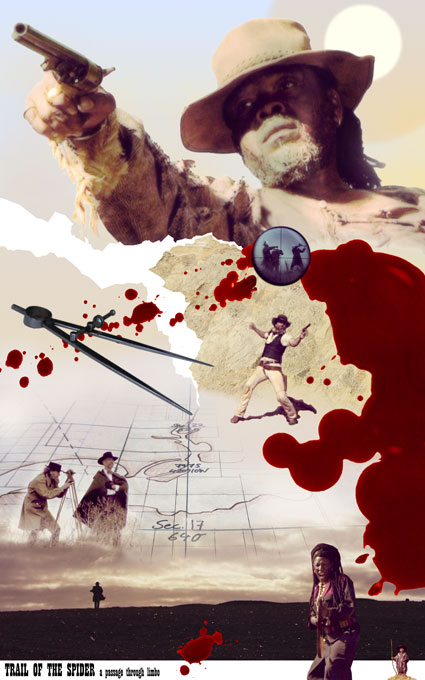
The film also addresses class conflict and displacement in East London today. By using standard Western plot devices of the ‘arrival of the railroad’ and the ‘end of an era’, Trail of the Spider explores the compromises and struggles of a population facing a new order of property speculation and gentrification.
The screening will be followed by a Q&A with the makers of the film + bar and DJs MIZ CB2000 & guests.
Thursday 24 July 2008.
7.30pm doors |8pm screening | party ’til late at Chats Palace Arts Centre, 42-44 Brooksbys Walk, Homerton, Hackney, London E9 6DF
Entrance FREE
Paul Meme interview in Pitchfork
Also grime artist Young Dot aka Dot Rotten.
Paul’s Devotional Dubz 12″ is out now.
books what I have read recently
(excluding ones about The Cramps, that is)
Sukhdev Sandu – Night Haunts: A journey through the London night (Artangel/Verso 2007)
Sukhdev gave Woofah a nice review in New Statesman and this book came highly recommended by History Is Made At Night amongst others. Each chapter is meander through the life of a particular aspect of London’s night – taxi drivers, Samaritans, cleaners, nuns, sleep researchers, exorcists and police inna helicopter. There is a literary/poetic blurriness to it all which I like very much, as well as some good sideswipes at the New Labour project. “The side of London that the tourists never see…”
Lynsey Hanley – Estates: An Intimate History (Granta, 2007)
Lynsey grew up on an estate near Birmingham and this combines her account of growing up there (and escaping) with a well observed social history of council housing in the UK.
It’s a thorny tale of politicians, architects and planners whose schemes (no matter how well-meaning) end up as political footballs which are kicked about and then consigned to the dustbin. Hanley makes the point that the overwhelming majority of these professionals will never live in their creations and that this inevitably leads (at best!) to a class-based short-sightedness.
Hanley is especially cutting about the architect Le Corbusier and his disciples, and their construction of concrete “streets in the sky” which are intended to be “machines for living”. This is topical again now that some architects are calling for the preservation of Robin Hood Gardens in East London, against the wishes of its residents.
It’s not all social policy though, there are a load of anecdotes from her own life and other estate dwellers, as well as a mention of topics such as psychogeography and the classist bullshit such as the “pram face/council facelift” phenomena emanating from Popbitch, the gossip e-newsletter edited by Oxbridge graduates.
Overall though, Estates is a story of the early idealism of “housing for all” being poorly implemented and then fucked over by market forces.
James Surowiecki – The Wisdom of Crowds: Why the Many Are Smarter Than The Few (Little, Brown 2004)
A fascinating book which overcomes its “business/psychology” category to reveal some crucial points about creativity. The thesis is essentially that collaboration trumps “genius” and what the ultra-left call “the myth of the great man”. This is especially useful for me as it counteracts some of the elitist individualism of some of yer social darwinist neofolkers. Indeed the author begins by considering (and providing evidence to reject) the ideas of Gustave Le Bon, someone who is much loved by Boyd Rice.
The overall slant is geared towards people who have control over the placement of staff or resources (with the general advice that “silo” working with specialists is counter-productive is most cases) but don’t let that put you off.
Drew Daniel – 20 Jazz Funk Greats (Continuum 2008)
Part of the 33 1/3 series in which seminal albums are written about in depth, the essays appearing in cute pocket books. This one is about a Throbbing Gristle album, a group who have always had interesting things to say.
At times this gets too much into the musicality and equipment rather than the context (you will probably have noticed that I rarely write about the actual notes, noises and chord progressions of things I cover here). But there is a great deal of interesting information about the people involved from their own mouths, and the times in which the album was made (for example there is an extended conversation about the parliamentary politics of the time and Thatcher being elected in 1979).
As Daniel notes in his introduction, anything on da Gristle is overshadowed by Simon Ford’s definitive Wreckers of Civilisation, but to my mind this has allowed him to do away with too much background stuff and focus on specifics. I especially enjoyed the discussion of the photo shoot for the cover at Beachy Head and how the album was designed to confound the expectations of the increasingly camo uniform-ed TG fanbase. Other highlights include Cosey offering up a musical and clothing set list from her days as a stripper, plus some discussions about disco, Martin Denny and Nic Roeg. Genesis P-Orridge is on good form as ever.
On the downside, I wasn’t exactly thrilled by the following exchange:
Drew: “What about the taped [voices] on ‘Persuasion'”
Sleazy: “I’d have to listen to it again. There are some recordings that I made of a friend of ours who was a pedophile in LA but I don’t think I had them at the time. I don’t think I used them until the first Coil album [which was released in 1984 – JE]. […] Actually I have a feeling that this guy sent some tapes of him and some ten-year old boy or something, and the boy was just laughing basically, just giggling and screaming and stuff, but there was nothing sinister about the activity on the tape, it’s just that it became sinister in that context. I was very interested in how people’s perceptions change as a consequence of context. […] The guy who I’m talking about had to leave the US in a hurry in 1982 and then moved to Amsterdam and then had to leave Amsterdam in a hurry in the late eighties I think.
Drew: “Even though the recording that you used doesn’t constitute a document of pedophilia.
Sleazy: “No, and I wouldn’t have included it if it had. It’s just a context thing. Everything’s to do with context.”
I wonder what context would lead a pedophile to have to move in a hurry on two occasions? And where that ten year old boy is now? And if he has heard the record
Monsieur Dupont – Nihilist Communism: A critique of optimism – the religious dogma that states there will be an ultimate triumph of good over evil – in the far left (2003)
Dupont is the collective pseudonym for a pair of UK based left-communists. The Monsieurs’ thorough critique has forced them into a completely new area of cynical reflection. I’ve mentioned their work in passing before on here and this work takes their black humour and unabashed iconoclasm to a new level.
Key aspects would be include rejection of the role of class consciousness in revolution (and consequent rejection of the role of political parties who seek to transmit this consciousness to potential revolutionaries), and also a jettisoning of Marx’s “stages theory” which suggests that revolution leading to communism is an inevitability. Their message to hectic political activists is “do nothing”, which has obviously caused a certain amount of friction with people who are doing a great deal.
That probably makes it sound dull, though, which it isn’t. Whether or not you agree with the ideas being put forward (and I only agree with some of them), they are all argued in an entertaining and coherent fashion.
Michael Billig – Psychology, Racism & Fascism (Searchlight 1979)
An intriguing and critical look at “scientific racism” and the adoption of Eysenck’s ideas on race and IQ by the National Front and others.
Jason Toynbee – Bob Marley: Herald of a Postcolonial World? (Polity, 2007)
The cover just says “Bob Marley” but you’re only a few pages in when a torrent of academic methodology is unleashed. Admittedly the author does ask non-academics to skip Chapter 1, but like a fool I didn’t and soon got lost in a wilderness of Critical Realism, Agency, Bourdieu and the ‘transformational model of social activity’ or TMSA. And y’know, I don’t shy away from things with big words and footnotes in them!
If you take the man’s advice and pass over Chapter 1, you are into a pretty good account of Bob Marley’s life and ascendance to become “the only third world superstar”.
It is a thought provoking book which avoids trainspottery tick lists of facts and instead asks some new questions about Marley’s role as an icon after his death, and as a celebrity in which many saw messianic or political answers during his life.
There are some good observations. A section on the differences between Island-era Marley and JA reggae places the glossy stereo “Get Up Stand Up” against Dennis Brown’s rawer “Westbound Train” and asks:
“Why bother with chord changes when you can produce spine-tingling tension simply by bringing up the echo, or shifting your voice through twenty-five shades of mellifluousness?”
Whilst I think the book is positive and affectionate, the author doesn’t hold back from criticising the Myth of Bob, for example:
“Jamaican democratic socialism represents an illuminating contrast with Marley’s own politics in which advocacy of radical social change was combined with rejection of the sort of practical measures which might achieve it.”
Well worth checking if you are interested in the politics of reggae music, but a bit heavy going for me.
Anti-Fascist Action – Heroes or Villians? (1998)
A timeline of militant (i.e physical) British anti-fascism from 1933 until 1992. It’s inspiring stuff, the audacity of some of the anti-fascists should bring a smile to everyone except hardline pacifists. There are also some moments of wonderful black humour:
EDINBURGH 1977
Michael Napier was fined £30 for punching John Tyndall in the face at a counter- demonstration against the NF in Edinburgh last year. His defence – “I was justified in hitting him six million times over. He has in the past committed himself to the extermination of thousands of Jews. My very mild blow cannot be compared with the gigantic crime he wishes to perpetrate.”
The introduction sets the scene (in some ways the text is a response to AFA being banned from holding its International Conference at Camden Town Hall on the grounds that it was prepared to use force against fascist groups) and is at pains to point out that the pamphlet is not designed to glorify violence. It asks the question: “At which point in this continuous tradition of confrontation do you draw the line and say physical opposition to fascism is no longer acceptable?
Daryl Davis – Klandestine Relationships: A Black Man’s Odyssey in the Ku Klux Klan (Vision, 2000)
Davis is a Grammy award winning blues guitarist who became obsessed with the Klan and decided to find out as much as possible about them. He ended up meeting up with various Klan members and even befriending some of them.
The book includes a fair bit of information on the origins of the Klan and the differences between various factions (including the fairly arbitrary membership criteria – whether or not native American Indians or catholics are allowed to join seems to vary the most) and some heated situations when Klan members are asked to explain their views and contradictory viewpoints. Davis always arranges his meetings with KKK members by phone which leads to some confusion when his interviewees meet him and discover he is black. Needless to say, some of the Klan’s most racist members have never really had anything to do with a black man before.
The author’s Christianity means that all of this is undertaken in the spirit of forgiveness and brotherhood, which provides for a few eyebrow raising moments. Having been a victim of racist policing, he is surprised that sometimes the Klan don’t get a fair deal from the cops either and this initiates a slightly unnerving sub plot in which he basically argues for civil liberties for organised racists. For example when he invites a Klan acquaintance along unannounced to a TV chatshow about racism, Davis is outraged when the Klan member is refused entry when his identity is discovered. Davis refers to this incident as “racism in the making”.
That aside the book is a worthwhile contribution to understanding the roots of racism in America and kudos to the author for putting himself in difficult situations during his quest. It seems to have paid off as well, his moderating voice leading some people to quit the Klan and others to reign in the white supremacist aspects of what they are doing.
Readers’ Cramp
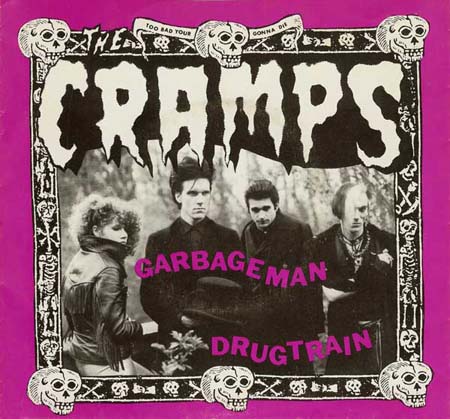
Ah, The Cramps. The cooler kids at school all seemed to get into them at exactly the same time, flashing their records about and drawing that classic logo on their bags.
It looked like my interest in punk and obsessive viewing of b&w re-runs of The Munsters and Addams Family all wrapped up in a perfectly kitsch package…
A great band who had a strong aesthetic and produced a mutant strain of decades old musical DNA – bang up to date stuff, not a tribute act. Just like The Specials with ska and two tone, The Cramps revved up obscure rock ‘n’ roll from the fifties and spawned (for better or worse) the whole psychobilly movement.
I think some people see them as a bit of band for poseurs, but for me their first three albums: “Songs The Lord Taught Us”, “Psychedelic Jungle” and especially the “Off The Bone” compilation of early singles and EPs are pretty much unassailable.
CDs (for yea, I have recently rediscovered them long after the C90 cassettes have perished) to dig out now and again when I need a breather from all things JA and East London. Maybe it’s my musical equivalent of escapist schlock like Barbara Cartland? I’d never really thought about the band very much which is unusual for an arch-spotter by me, so I was surprised when my spidey sense started tingling recently.
The first thing that did it was a long car journey with Andy from Giant Paw during which he played a whole welter of mad stuff including many original versions of songs covered by The Cramps. They were uniformly excellent – little blasts of intensity with a wicked pop sensibility hiding some 50s sleeeeeeeze. I hadn’t realised I was so familiar with the versions by The Cramps, but hearing the originals was as pleasantly jarring as the first time I stumbled on the full vocal version of a dub by Scientist.
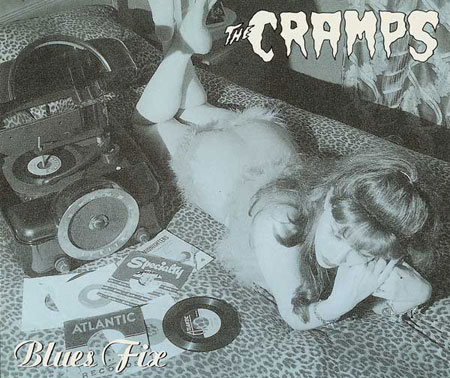
Smith3000 who does Expletive Undeleted also came up trumps with this great entry about “Off The Bone” – which like many of his posts manages to combine some top writing about music with reminiscences about times, and girls, gone by.
By this point I was cursing myself because I could feel that disembodied love for The Cramps beginning to move into a zone of analysis and trainspottery. I started thinking about them, the whole mondo gothic pinup schtick. Remembering when I’d seen Poison Ivy Rorschach on the cover of “Smell Of Female” in Our Price and my adolescent eyebrows tried to hit the ceiling.
I wanted to know more about them, what made them tick. All the while realising that this might mean that I could never “just” like their music again. Like a dog eating its own vomit.
So that’s how I ended up going digging in the boneyard of The Cramps’ back catalogue and associated world of fannish obsession. My first stop was a thread on Dissensus, followed by all this lot:
Lindsay Hutton – Rocking Bones / Legion of the Cramped 1979-1983
Rocking Bones was a fanzine which became the official Cramps fan club newsletter for a period. The Legion of the Cramped was administered by Lindsay Hutton (helped initially by one Stephen Morrissey, – yes that one). The fan club was terminated by the band in 1983, Ivy’s letter was the main content of the 7th issue.
I quite like “ziney” feel of it – the usual apologies for lateness, gig reviews, gossip, press cuttings etc. Lo-fi but undeniably enthusiastic.
A few issues are available as pdfs online.
Thomas Owen Sheridan – The Cramps (Savoy, 1990) 60pp
A bunch of photocopied of press interviews and reviews, mainly from the UK, up to and including mid 80s. Includes quite a few photos (tho not exactly great quality given the medium) but feels very much like a scrapbook – quite “bitty”. “For die-hards only”.
Still available from Savoy – support independent publishing!
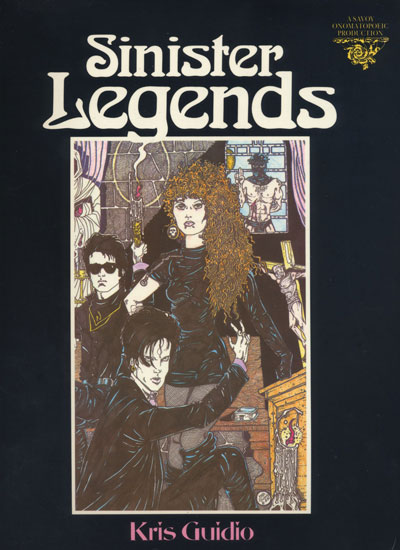
Kris Guidio – Sinister Legends (Savoy, 1988) 112pp
A collection of drawings and cartoons by “The Cramps’ favourite artist”. Guidio’s later work Lord Horror and Meng & Ecker is now notorious for riling Manchester’s newly formed Obscene Publications Squad, headed up by Chief Inspector James Anderton.
The book includes all of the cartoons featuring the Cramps which appeared in Hutton’s The Next Big Thing zine as well as a bunch of artwork relating to a whole constellation of post-punk and quasi goth figures. There is also an interview with Guidio himself about his early life, heroin addiction and more besides, some fiction, some (ugh) poetry.
I’m not a big fan of his artwork here. It’s a personal thing but for me it veers too far away from the Cramps’ kitchy Americana pin-up aesthetic into gothic. Lux Interior likes it though: “This was rock ‘n’ roll. I loved the stuff he did for us”.
Still available from Savoy – support independent publishing!
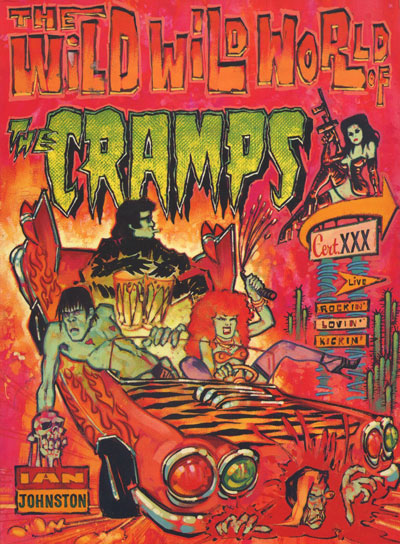
Ian Johnston – The Wild Wild World Of The Cramps – (Omnibus, 1990) 128pp
Exhaustive, but now expensive. Ian has read every single thing ever written about The Cramps, so you don’t have to wade through it all!
It’s really well written and each page has a shed-load of graphics – flyers, photos, posters etc. The visual appeal of the band is so strong that you feel that this was both a labour of love and also the sort of book the band might like.
The book relies a lot on music press coverage and interviews but the process of distillation is done really well (and it’s basically how a lot of stuff on this blog is done, so what the hell!).
There are also a fair few original quotes from people like Lindsay Hutton, especially in relation to the band’s decision to close down the fan club he was running because Ivy felt they “shouldn’t be pinned down and defined”. Which is kind of what I was trying to do, ah well.
The book tells the story up to 1990 and it is a great story to tell. If you find this cheap, snap it up.
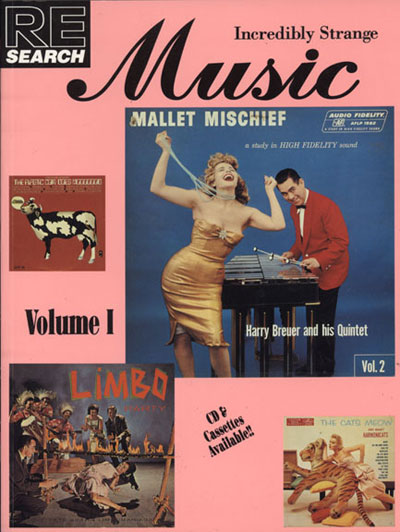
V.Vale (ed.) RE/SEARCH #14 – Incredibly Strange Music vol. 1 (RE/SEARCH 1993)
Difficult to argue with RE/SEARCH, really. Full marks for thoroughness and presentation every time.
The interview with The Cramps is the first in the book and focuses on them as record collectors and curators of a bygone age. Lots of cool tales of record digging (they broke an axle on their car returning from a sale at the Sun Records warehouse…) and general enthusiasm about finding mad records cheap.
Other highlights include interviews with Earth Kitt, the Norton Records label (co-run by Miriam Linna, an early Cramps drummer) and Martin Denny.
The irony here is that many of the people interviewed are cursing Record Collectors who go around with price lists rather than just trusting their ears – but RE/SEARCH has always worked as a populist force for underground subcultures (their “Modern Primitives” especially being the book which launched a million identical “individualist” tattoos and piercings). This book and ebay and healthy bank balance may be your passport to cool. Or maybe not.
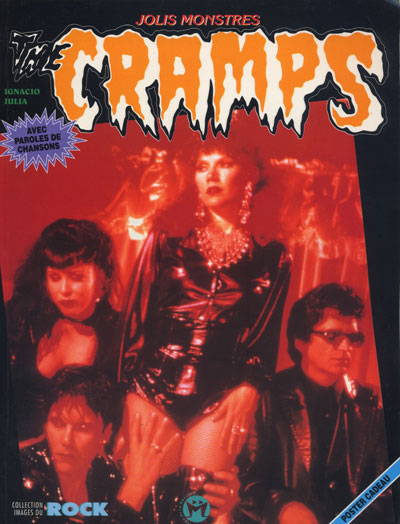
Ignacio Julia – The Cramps: Jolis Monstres (1995) 64pp
On the upside, this has a whole heap of photos in – many in colour. On the downside, all the text is in French.
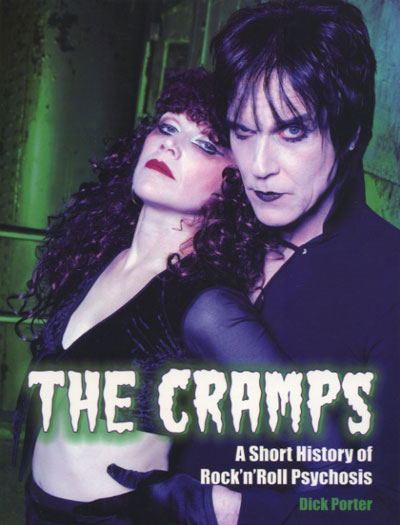
Dick Porter – The Cramps (Plexus, 2006) 144pp
The most recent addition to the bookshelf and therefore the most up to date. Perhaps predictably, the bulk of the book still focuses on the period up to and including the mid-80s. Admittedly this is the most interesting era of the band – including their formation and classic releases. The early years are now given more attention because of quotes from Lux and Ivy reflecting on that period which were not available to Ian Johnston for his book.
For example there is more detail on Lux’s former incarnation as a hellraising hippy who changed his name by deed poll to “VipVop”.
And this from Ivy:
“The failure of outsiders to acknowledge the influence of blues and R&B on The Cramps is an omission bordering on racism. Rockabilly is rooted in the blues and we consider ourselves a blues band.”
Actually she comes across as amazingly talented (and hard nosed) in most of the books. It’s cool that she taught herself to produce records and run a business. It’s also cool that virtually all of the album covers have been shot in Lux and Ivy’s front room – that says something quite good about them in my world.
Porter’s style flows slightly better than Johnston’s as I think he is less hidebound by covering things in as much detail as possible.
On the visuals front, Porter’s book has a few photos reproduced in high quality and is still widely available. “Wild World” has superb illustrations and photos on every single one of its glossy pages but will cost you in the region of 30 quid on ebay, or less if you are prepared to wait and seek a bit deeper (as I was).
I think I’ve got most of it out of my system now though…
Hackney Solidarity Network
“The Hackney Solidarity Network (HSN) was launched in January 2008 as a space where community activists and campaigners can
- Meet each other
- Let each other know what they are doing
- Share skills and information
- Network and get to know each other socially
At each meeting we have a short introductory presentation by an invited community group, followed by a discussion and reports from other campaigns present.”
The next meeting is…
HSN Meeting: Presentation from Hackney Trades Union Council. 7.30pm, June 30
